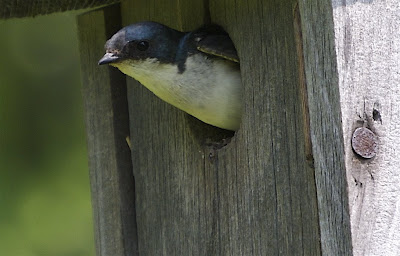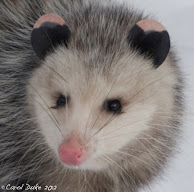



















I am not certain but it might be the full moon that has made the tree swallows mad. While walking into the south field, as I have done countless times this spring and summer, I happen to notice wild honey bees sipping milkweed nectar not far from the tree swallow house. I became engaged in observing and photographing both flower and bee.
Suddenly the tree swallows began dive-bombing me! What was going on?!! I thought to myself. I had been so close to them over this season ... during their courtship, while the female was building her nest, when she was laying her eggs and during this entire feeding time, when both male and female were busy swimming in the sky, as a killer whale in the ocean (they do have similar color patterns), for food. They certainly took on a more killer personality with their forceful flight using my head as a target.
I was indignant and most confused. When they realized I was not going to be bothered by their tantrum, they left me alone for a bit. I then was able to take quite a few shots of them and truly believe these are not the same birds! Now I could be mistaken but perhaps you will help me understand... if you look back at the other posts on tree swallows you can clearly see that the female especially looks very different. I know parenting is trying at times and may bring about premature aging, but this female, who was encouraging the male to get rid of me, does not look the same... the shape of her head is very different. Perhaps the moon is tilting my brain too and this aggressive behavior is due to their little ones being about ready to fledge. One of the babies did peek out after the strange female flew off. Even the little Common Yellow-Throats came out to see what all the fuss was about. A not so pleasant mystery!
The sane honey bees are busy enjoying the Milkweed (Asclepias syriaca) nectar. A plant with a name as lovely as its blossoms. Its perfume is floating around the garden and I am longing to see a Monarch Butterfly. All the rain has kept the great navigators away. Hoping for their arrival any day! The female will lay up to five hundred eggs around on all the younger milkweed leaves. If I find any eggs on milkweed in the paths, I will take them inside to my studio and raise the emerging colorful caterpillars, as if they were beloved pets, until releasing them as butterflies into the gardens. I have done so for over twenty years now each summer documenting their metamorphosis and marveling at their antics.
Milkweed is an important plant to grow for its beauty but more for its importance as food for bees, butterflies and hummingbirds. It is vitally necessary for the life of the Monarch butterfly, as it is the host plant for the caterpillar. No Milkweed ... No Monarch Butterfly.





























































.jpg)



































































